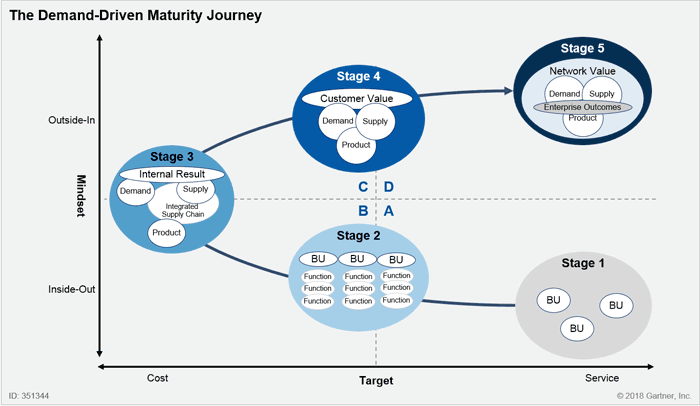SCDigest editor Dan Gilmore this week as usual wrote his annual summary of the Gartner Top 25 supply chains for 2018, with the list itself, a comparison to the top 25 in 2015-2017, a detailed summary of the methodoloy used, and some advance on companies wanting to reach the top 25. (See Understanding the Gartner Top 25 Supply Chains 2018.)
As Gilmore notes, the evaluation of supply chainy a excellence by a group of supply chain professionals and then also a number of Gartner analysts is supposed to be guided by Gartner's Demand-Driven Value Networks (DDVN) framework.
What is that? It is in part a maturity model, in which companies may go through a journey from being very siloed and internally focused to a more "outside in" view to ultimately what Gartner calls supply chain orchestration.
One representation of this from Gartner is shown in the graphic below:
Gartner's 5-Stage DDVN Maturity Model

Relative to this model, Gartner says that "The demand-driven value network (DDVN) model is characterized by an understanding of customer value with processes and metrics that enable business trade-offs to deliver products and services profitably. Companies that work toward the DDVN ideal use demand management as a key differentiating capability, so they can plan, sense and shape in a way that brings profitable balance to the business. They also design supply networks to be more closely aligned with the development of product platforms that enable innovation, agility and responsiveness."
It adds that "
We find that companies that continually secure spots on the Supply Chain Top 25 have successfully shifted from the traditional disconnected approach to managing supply, demand and product to an integrated approach to coordinating plan, source, make and deliver functions across the end-to-end supply chain."
So there you have it. Time to get busy.
Any Feedback on our Supply Chain Graphic of the Week? Let us know your thoughts at the Feedback section below.
Your Comments/Feedback
|